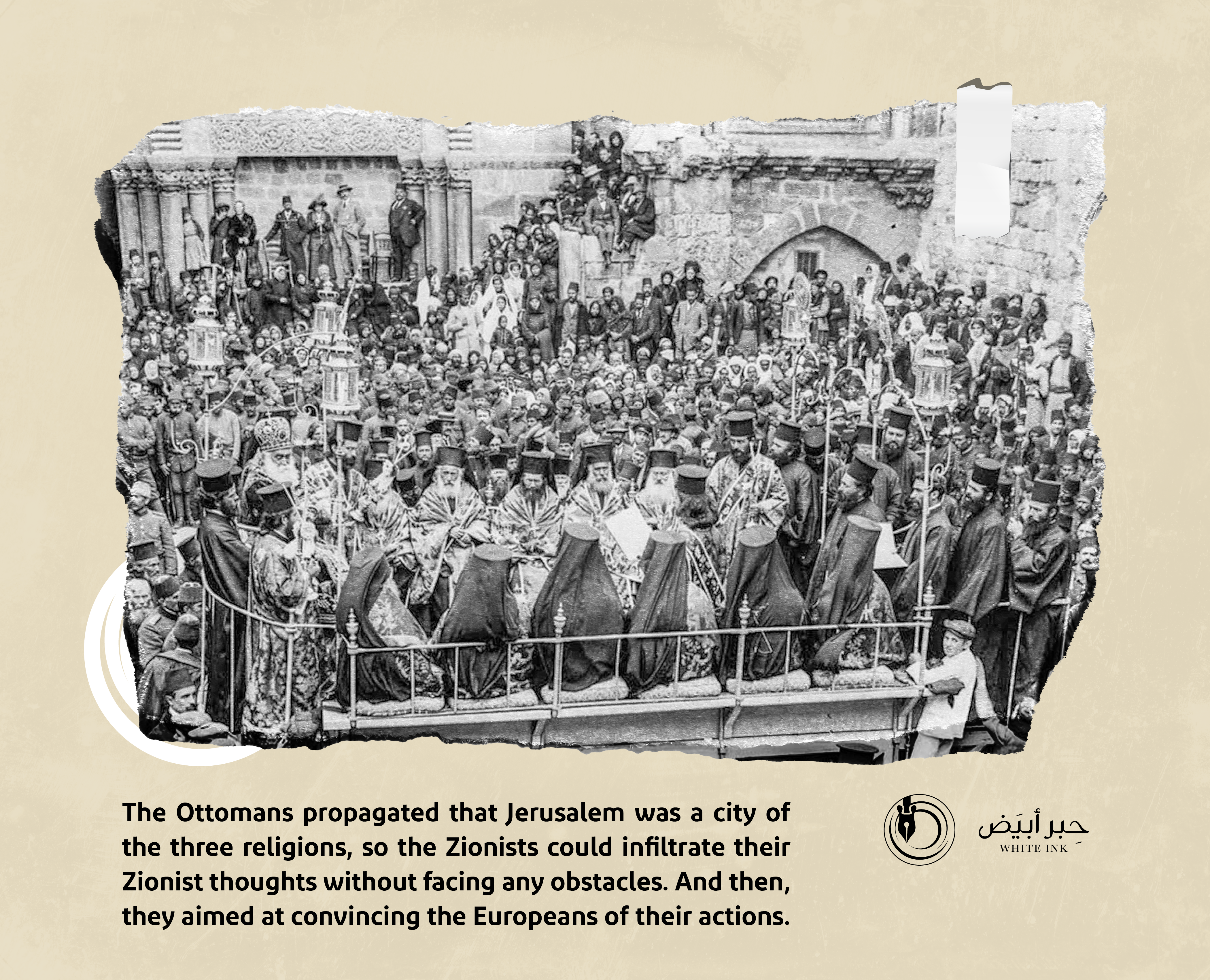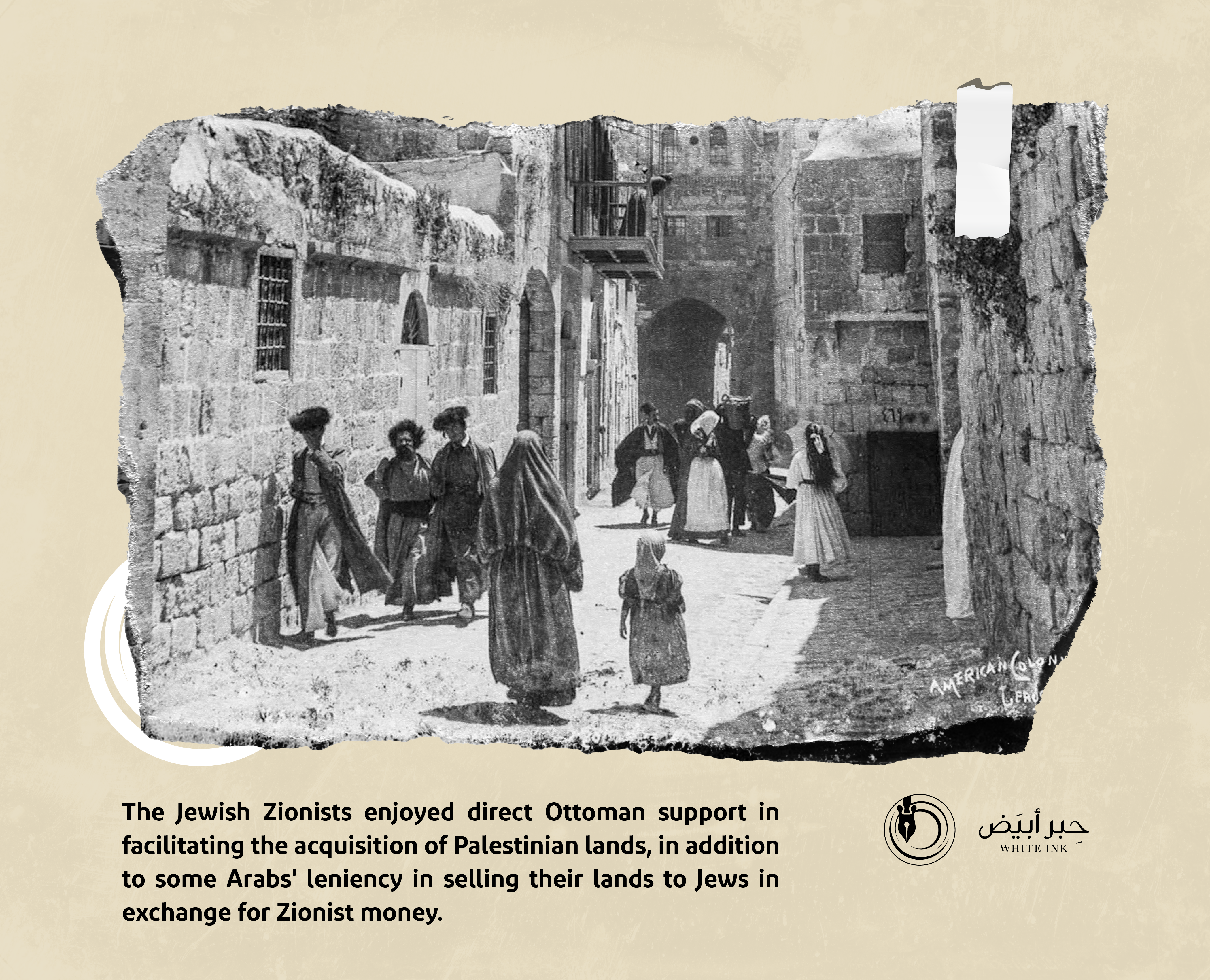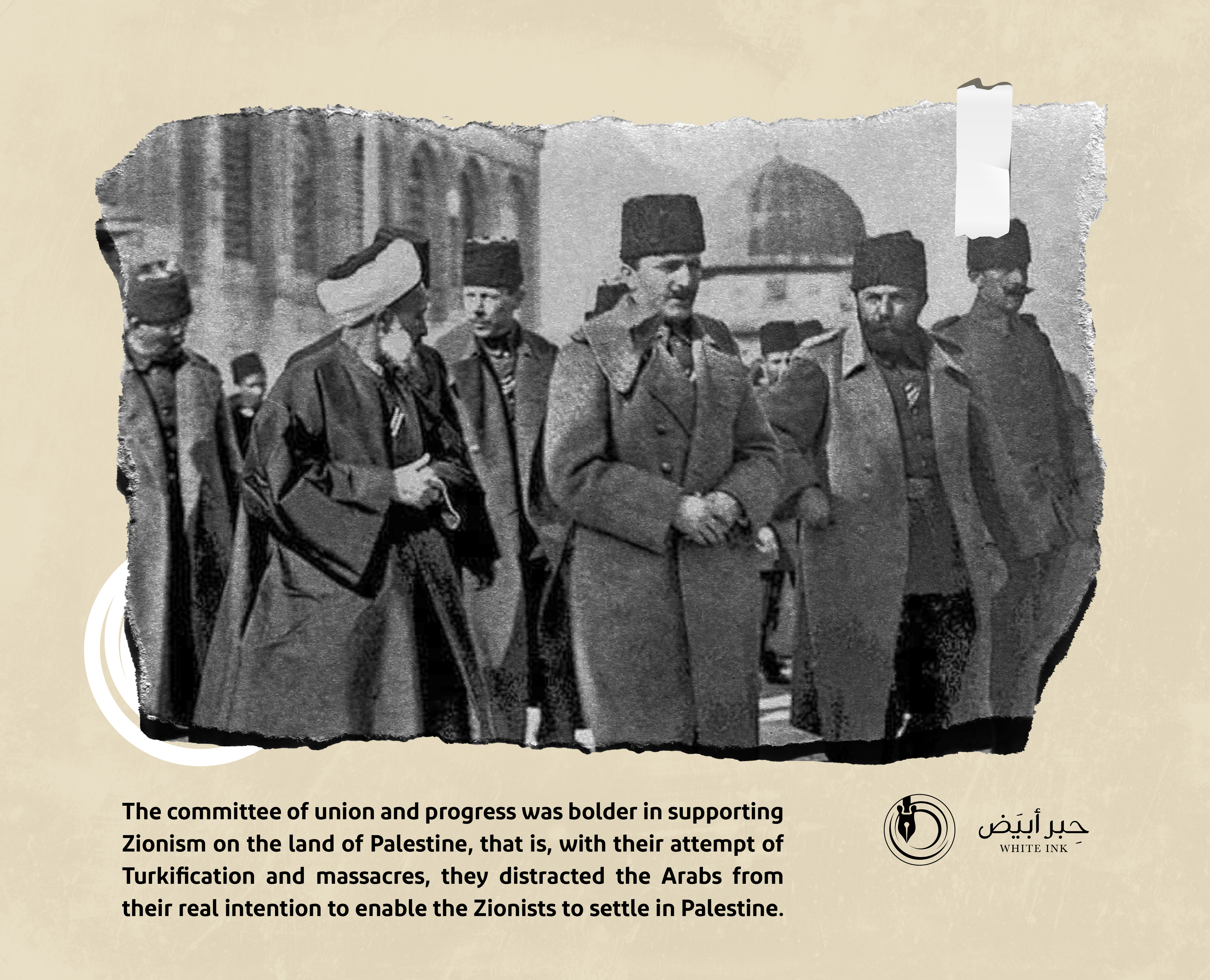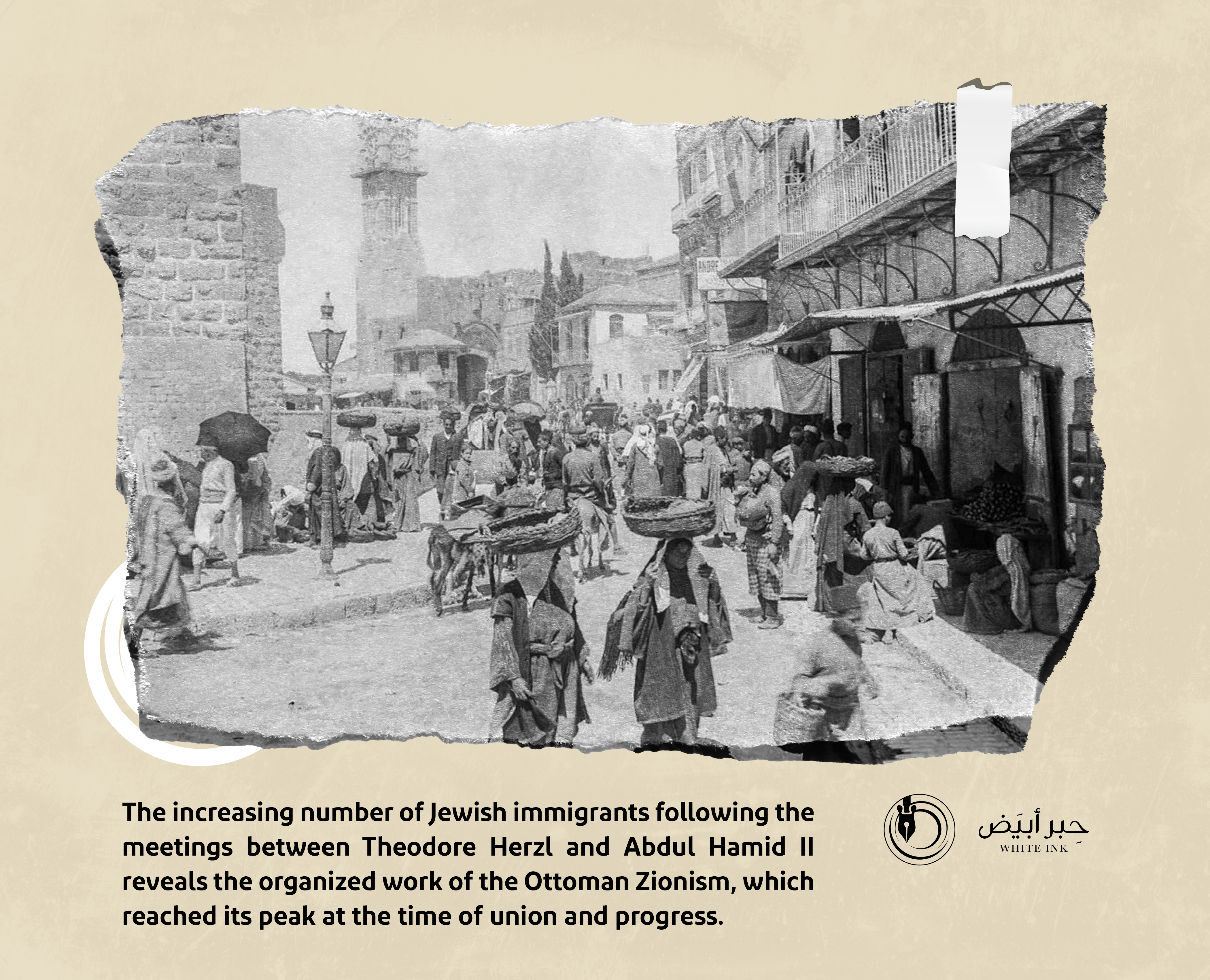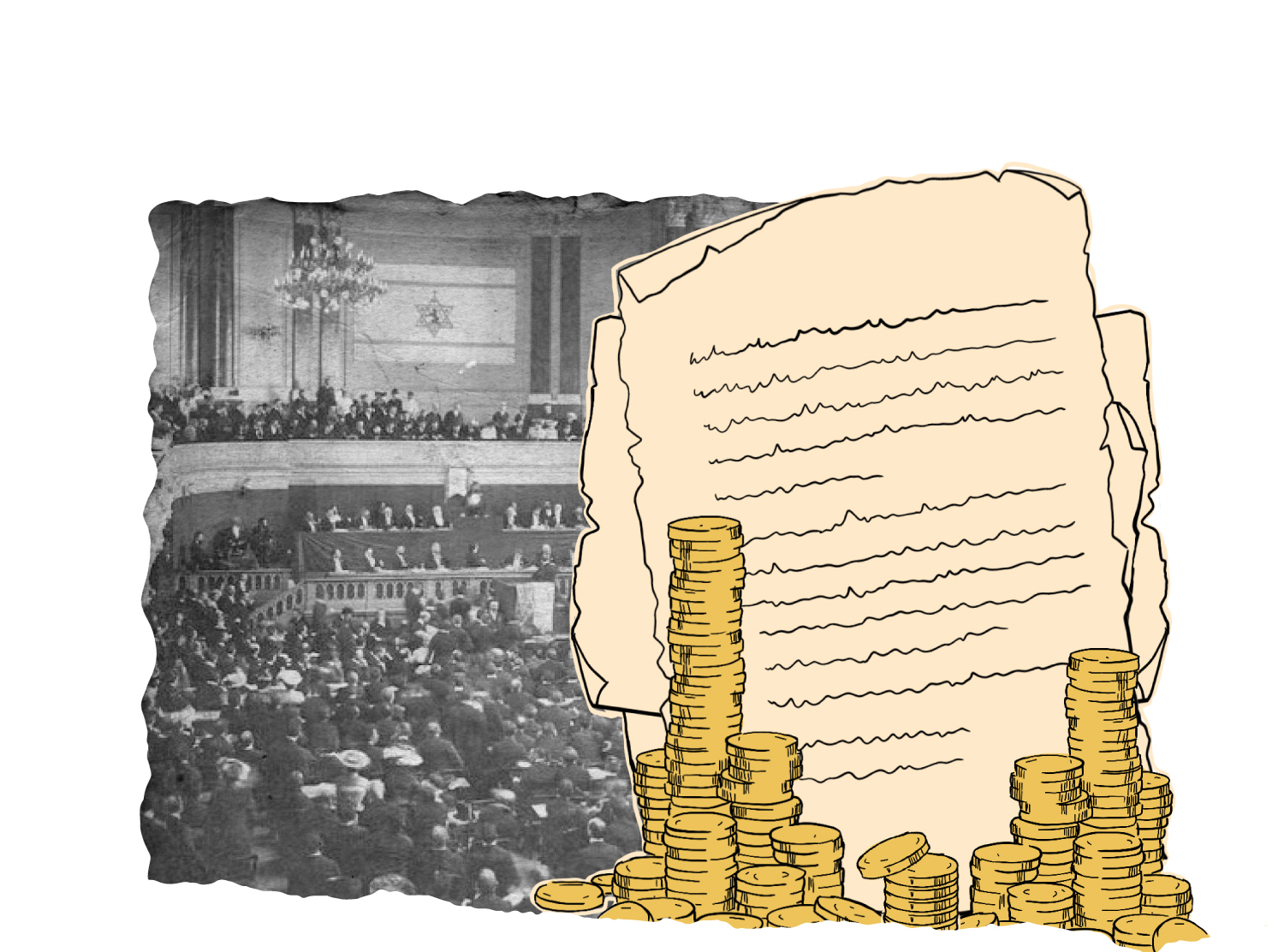
Abdul Hamid II
Sold Palestine and silenced the Arabs and Muslims with propaganda and suppression
Honoring the head of the Zionist movement, Theodor Herzl, with the Majeedi Medal by Sultan Abdul Hamid II, was the culmination of a long and deep friendship that Herzl described as great, after the negotiations had resulted in the Zionist movement’s support for the faltering treasury of the Sultanate and for the Sultanate’s negotiations in international forums, especially with their European creditors. In his memoirs, Herzl wrote about his relationship with Abdul Hamid and his sultanate, describing this historical moment after receiving the Majeedi Medal by saying: “When your Majesty graciously accepts the services of the Jews, they will be glad to put their forces at the disposal of a great king like you”.
The financial support to the treasury of the Ottoman Empire was not a financial loan that the Sultan took to pay off the accumulated debts of his state. Rather, it was a “Zionist” gift that came as an expression of gratitude from the Zionist movement towards the efforts made by Abdul Hamid II in service of the Jewish settlement project in Palestine, which was occupied by the Ottomans.
Those who think that the relationship that developed a lot between Abdul Hamid II and Herzl was an abstract diplomatic relationship, as described by the supporters of the Sultan and his image improvers in the Arab world, are mistaken. Herzl is nothing but a long episode of the rooted relationship between the Jews and the successive governments of the Sultanate from Mehmed II to Abdul Hamid II.
The Jewish movement was part of the Ottoman financial, political and military system. When the movement thought of establishing a national home for the Jews on the land of Palestine, it only found the Ottoman Sultanate, the “close friend” of the Zionists, to start its project from there. When Herzl built his relations with Abdul Hamid II, the political situation was ready to develop.
In his memoirs, Herzl talks about his secret relationship and friendship with Abdul Hamid II, saying: “Abdul Hamid promised us an independent Jewish state in return for paying his debts”. That text is only one indication of thousands of evidences of the depth of the relationship that eventually resulted in the sale of Palestine.
Abdul Hamid and Herzl’s negotiations began with secret correspondence at first, until they reached a conclusion entitled: “Money in return for Palestine”. Negotiations lasted eight years (1896-1903), during which Herzl made five visits to Istanbul.
Theodor Herzl, the founder of the Zionist movement, revealed that Abdul Hamid II had agreed to sell Palestine to the Jews.

In his book “The Ottoman State’s attitude towards the Zionist Movement”, The Lebanese academic Hassan Ali Hallaq explains how Sultan Abdul Hamid II received Herzl warmly and described him as a loyal friend as he begged him to save his state from bankruptcy.
Herzl based his negotiations on the Ottomans’ urgent need for money. He offered Abdul Hamid £20 million, as a result of which the Jewish immigrants were granted exceptional privileges and facilities. After that, Herzl returned to Europe and held the First Zionist Congress in Switzerland in 1897, declaring his Zionist goals to establish a national home for the Jewish people under Ottoman auspices.
We may remember that the Ottoman Empire chose the Axis Powers during World War I (1914-1918) to be in its alliance. Of course, Germany and Austria were the pillars of that relationship. Starting from that point, the role of the Austrian diplomat Philipp Michael Newlinski (1841 – 1899), who worked in charge of the political administration at the Austrian embassy in Istanbul, emerged and was able to build a close friendship with Abdul Hamid II.
In 1896, Theodor Herzl, founder of the Zionist movement, contacted Newlinski, asking him to arrange a meeting with a number of Ottoman leaders, led by Abdul Hamid II, to persuade him to help the Zionist movement in its project.
In his memoirs, Theodor Herzl mentions that Newlinski told him that Abdul Hamid trusted him. The Austrian diplomat suggested to Herzl that the best way to influence the Sultan was to support him in the Armenian issue, which was confirmed by Herzl in his memoirs about contacts he had with the Armenian leaders in Europe in order to pacify and accept Abdul Hamid’s offer to repair the relationship with them.
By looking into the reasons for the financial collapse of the Ottoman Sultanate in the last five decades of its history, we will find that extravagance and spending on the pleasures of the sultans were the first of those reasons. Mismanagement, appropriation of money without reinvesting it in the main state bodies and the bulldozing of industry, agriculture and professions in the occupied Arab countries led to their poverty and their inability to finance the Ottoman treasury. This was what made the Zionist movement intervene in an attempt to save their most powerful ally at that time by financing the Ottoman treasury.
The Ottoman Empire became debt-ridden. In September 1875, the Ottoman government announced the details of its budget, which showed a deficit of 4.5 million Ottoman liras, while debt interest expenditures in the budget amounted to about 9.68 million liras, more than double the debt. The Sultanate used a bad method in managing its debt, as it paid the interests of the debts by holding new loans, which plunged it into debt. The total external public debt of the Ottoman Empire amounted to more than £184 million, while the internal debt amounted to more than £20 million.
With the extortion of creditors, the rise in interest and the weakness of confidence in the Ottoman economy, the state was on the verge of bankruptcy and could no longer borrow from international markets. When the state realized that it was unable to pay the interest on its debts, Grand Vizier Mahmud Nadim Pasha decided on October 6 (1875) to issue a decree known as “Ramadan Decree” declaring that the government would pay only half of the annual interest in cash. The other half would be paid through bonds issued by the Ottoman government at 5% interest. This meant that the Ottoman government partially defaulted on its debts. It didn’t last long. At the beginning of the new year in April (1876), the government announced that it would stop paying all the interests of its foreign debts, which practically meant the bankruptcy of the Ottoman Empire.
Concurrently, the Austrian mediator Newlinski convinced Abdul Hamid II of the importance of the relationship with Herzl. The Sultan agreed to Herzl’s visit to meet with the heads of his government. This was the first visit, but later on, the relationship between the two parties became intimate.
Newlinski arranged a visit for Herzl to Istanbul in June (1896). He met with “The Grand Vizier” Javed Bey. The reason was to know Herzl’s intentions without considering it an official meeting. The content of the meeting can be summed up in three questions. The first was the fate of the holy sites “Al-Aqsa Mosque”. His promised him that they would be outside the borders of the Jewish state, to be for all religions and not for a single group. After that he asked him about the relationship between the Jewish state and Turkey, and Herzl said: “Despite my desire for independence, it is possible to reach a fictitious dependency, such as those in Egypt and Bulgaria”. The third question was about the type of governance in the Jewish state, and Herzl’s answer was: “Aristocratic Republic”. Javed advised him, saying: Never mention the word “republic” to the sultan because people in Turkey are afraid of it like death.
On the second day, the official meetings began, and Herzl met with Khalil Rifaat Pasha, who listened to him calmly, then said: The area of Palestine is large, which part of it do you want? Herzl said: It depends on what benefits we will provide.
Herzl concluded his first visit to Istanbul by meeting a man from the Ministry of Foreign Affairs, Nuri Bey, and offered him to liberate Turkey from the debt protection delegation that burdened the Sultanate, a delegation that aimed to ensure the Sultanate’s ability to pay its international debts. This is what Nuri Bey was pleased with, but he asked about the Islamic sites in Palestine, and Herzl reassured him, saying: “Remember that we are the only buyers of something that has no value at all and is of no use to the others and we buy at high prices”.
During Herzl’s first visit to Istanbul, he could not meet the Sultan, but he recounted in his memoirs, quoting the Austrian mediator: “When Newlinski met the Sultan, Abdul Hamid asked him: Are the Jews determined to take Palestine at any cost? Can’t they live in any other country? Newlinski replied: Palestine is their cradle and they want to return to it. The Sultan said: But it is the cradle of other religions as well. Newlinski said: If the Jews cannot take Palestine, they will go to Argentina”.
Herzl left Turkey on June 28 (1896) without meeting the sultan, but it was not the end. Herzl explained the matter in a letter he sent regarding his talks with the Ottoman Sultan to Zadok Khan, the chief rabbi of Paris and France and honorary head of the Hovevei Zion movement, in which he said: “The Sultan knew the Jews’ project in Palestine. He treated me with distinction that made me understand that the deal could be done if we found the appropriate formula. it is just a matter of saving face”.
He continued: “I have received the following offer from the entourage of the Sultan: The Sultan warmly invites the Jews to return to their historical homeland. They will enjoy self-government and be administratively independent, but subordinate to the Turkish Empire. In return, they pay a tax for him”. Herzl also talks about his contacts with Jewish politicians and financiers in London and Paris with the purpose of involving them in the financial support project.
A letter between Herzl and Newlinski published by the Institute for Palestine Studies says that the negotiations over Palestine had ended and it had already been ceded, but the last details were about the administration of Jerusalem itself.
Newlinski says: “The Sultan said that he would not cede Jerusalem and that Omar’s Mosque should always remain in the possession of the Muslims. I told him: We will manage this matter, and we will make Jerusalem outside the borders of the state, so that it is not for anyone alone and for everyone at the same time. The holy site belongs to all believers and it is a country of common culture and morals”.
Accordingly, the Zionist organization rushed to support the Ottoman Empire financially and in huge amounts. Here, the Palestinian Center for Studies also publishes the following document:
“Twenty million Turkish liras are spent in order to fix the financial situation in Turkey. Of this amount, we pay two million in return for Palestine. This amount is based on a capital transfer from the government’s current income, which is eighty thousand Turkish liras per year. Using eighteen million, Turkey will be liberated from the European protection delegation. As for the shareholders of the first, second, third and fourth classes, we will made them accept the removal of the delegation by giving them special privileges, higher interest and an extension of land ownership”.
In a study published by the researcher Nadia Ibrahim Hiasat about the care that the Jewish orphans received in the city of Jerusalem at the end of the Ottoman occupation, the researcher relied on an authentic primary source which is the records of the Sharia court in the city of Jerusalem. The research dealt with the property of Jewish orphans from several aspects, such as knowing the places where their property is concentrated, its quality and area, its official registration in the Ottoman government departments and their property bond numbers. The study also aimed to identify the procedures of the Ottoman Sharia court to appoint a guardian for orphans and to verify his ability to properly manage orphans’ property. The research included the necessary conditions for the guardians to dispose of the orphans’ property and to accurately monitor the orphans’ share in terms of its financial value in the event of selling it so that the court can be assured that the sale is in the interest of the orphans.
Palestine was not the only thing that the Ottomans offered for sale to the Zionist movement thirsting for an alternative homeland. To sum up the matter further, let us go to the palace of Sultan Abdul Hamid II in Istanbul and see him asking his aides to spread a map of his sultanate in front of Herzl to choose what he wants from the occupied countries and peoples. The whole thing was a direct sale of land that the Sultan did not own to those who did not deserve it.
At first, the Ottomans offered Iraq to Herzl. According to Nuri Bey, who was close to the Sultan and who negotiated with Herzl, this was due to the hesitation of the Sultan at first and his fear of the reaction of the Europeans, as he was not sure of their approval of the sale, especially with the presence of a Christian romance with Palestine. His greatest fear was that the European countries would send their armies and occupy Palestine. Of course, Abdul Hamid was indifferent to the Islamic and Arab public opinion, which could be silenced through the Ottoman propaganda and suppression. The Sultan continued to prepare the land in Palestine for the Jews by changing the laws, granting them Ottoman citizenship, helping them to settle and protecting them. He also stipulated that Herzl should obtain the approval of the European countries because this would facilitate the task. Herzl told him that he would calm these countries.
The researcher Ibrahim Gharibah quoted parts of the book of the Jordanian researcher Fadwa Nuseirat, “The Role of Sultan Abdul Hamid II in Facilitating the Zionist Control over Palestine”, revealing the details of the Jewish settlement in Palestine and its development during the reign of Sultan Abdul Hamid. The following text came:
“During the reign of Sultan Abdul Hamid II, organized Jewish settlement operations started to take the form of independent cities and settlements outside the traditional main cities of the Jews, namely Safed, Hebron, Jerusalem and Tiberias. The Jews established a great variety of schools, hospitals, factories, and banks. In her book, Nuseirat presents a table of more than 100 settlements established during the reign of Sultan Abdul Hamid, including the name, location and year of foundation. She also presented information about dozens of settlement associations, companies and banks that financed and sponsored the settlement and employment operations for Jews in Palestine”.
In 1897, the Jewish Agency headed by Herzl was allowed to own a wide range of lands and settlements. In 1900, the Jewish National Fund was established, which focused on financing the purchase of land in Palestine. In 1908, it owned about 90,000 dunams, 7,000 dunams of which were in Jordan Valley and 2000 in Hittin Plain.


- Ahmad Nouri Al-Nuaimi, The Ottoman Empire and the Jews (Beirut: Dar Al-Basheer, 1997).
- Hassan Hallaq, The Ottoman State’s attitude towards the Zionist Movement 1897-1909 (Cairo: Dar Al-Nahda, 1999).
- Fadwa Nuseirat, The Role of Sultan Abdul Hamid II in Facilitating the Zionist Control of Palestine (Beirut: Centre for Arab Unity Studies, 2014).
- Nadia Hiasat, Caring for the Jewish Orphans in the City of Jerusalem in the Ottoman Era 1902-1909 (Amman: Mu’tah for Research and Studies, 2017).
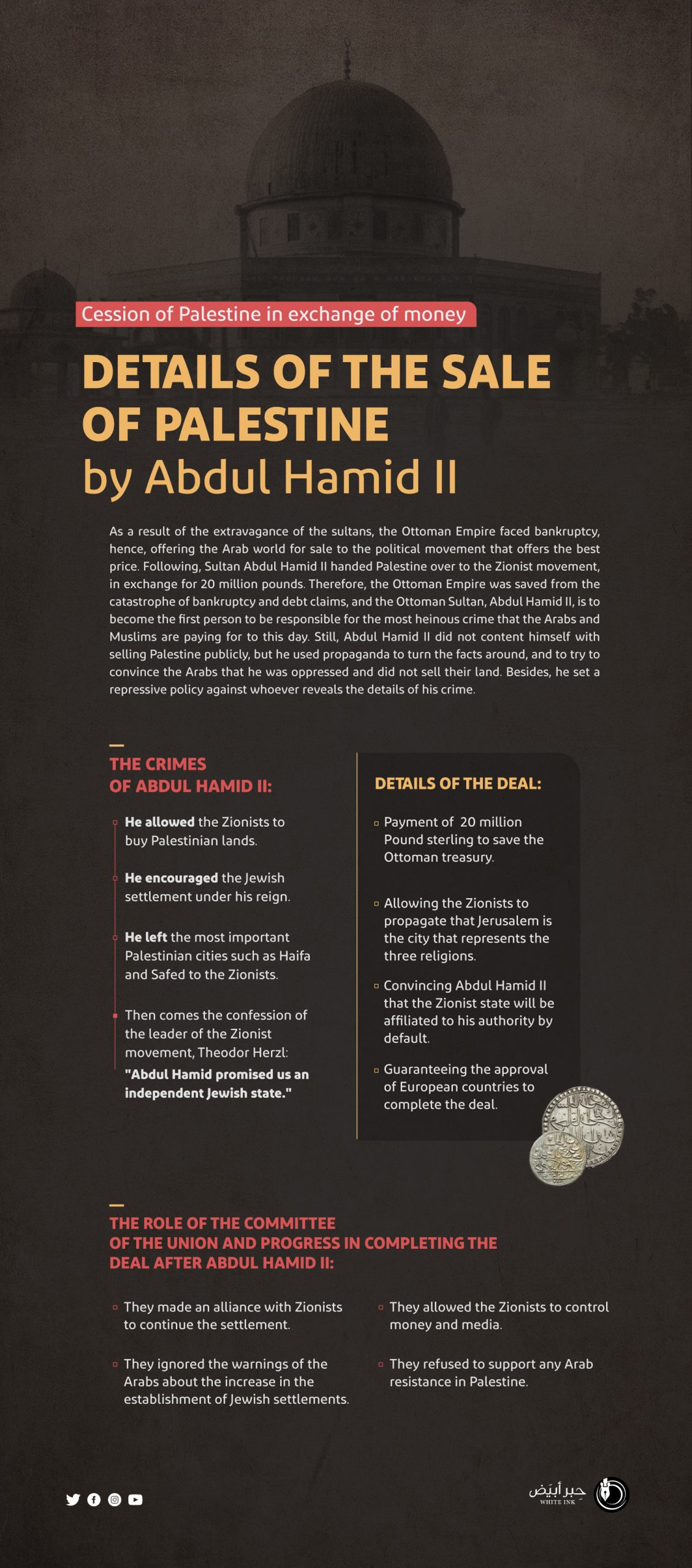
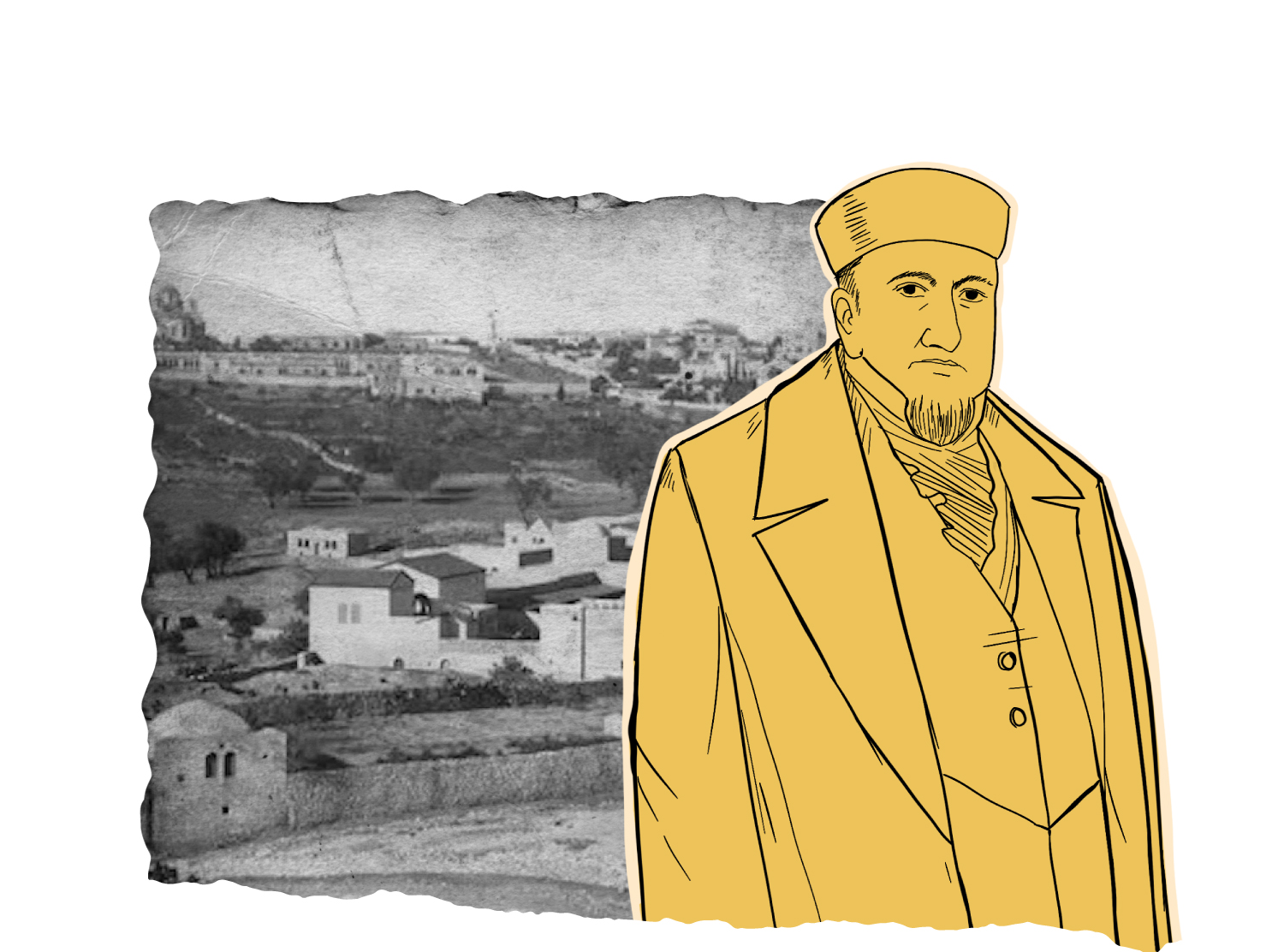
They ignored the Arabs' warnings and facilitated the establishment of settlements
"Federalists" They supported the Zionist settlement on the land of Palestine
Whoever delves into the history of the Ottoman Empire in its various eras, and its emergence as one of the colonial countries in the world, then its passage through stages of weakness and collapse, and the control of the Union and Progress Party over the reins of affairs in it and the beginnings of the end for the Turks, shall be well aware that the Ottoman position was lenient with the immigration of Jews to Palestine on the one hand. On the other hand, the Ottoman officials welcomed those migrations, in addition to that, the Zionists were able to employ myths and sayings to sow nostalgia in the hearts of the Jews, and push them to migrate and settle in and around Jerusalem, buy and hold lands outside the walls of Jerusalem, and build Jewish settlements to increase the number of Jews in Palestine; hence Over time, the imposition of the policy of the status quo.
In order to achieve their goals, the Zionists benefited from the interventions of European countries at the Sublime Porte, through their presence in Istanbul to discuss the issue of Jewish immigration to Palestine, as well as the extensive consular activity of the consuls of European countries, especially Britain, in Beirut, Damascus and Jerusalem, and pushing them towards facilitating the smuggling and immigration of Jews to Palestine, paving the road to their residence there, and buying land and property from major merchants and landlords in the interest of the Zionist project.
We cannot ignore the corruption of the Turkish administration in the Mutasarrifate of Jerusalem, the wide scope of their bribery, and their facilitation of all the activities and works carried out by the European consuls, in addition to the methods of deception and camouflage practiced by the Jews.
The Jewish settlement movement started in (1855) when the Jew, Moses Montefiore, who enjoyed British protection, was able to buy a land outside the city of Jerusalem from the suburbs of the daughter of Hussein Agha Al-Duzdar, then it was built on four years later, after obtaining permission to build from Istanbul, where twenty houses were built, so that this neighborhood became the first Jewish settlement in Palestine.
The matter followed after that, and with the passage of time the number of Jews in Palestine increased. For example, in the year (1880) the number of Jews in Palestine reached about 25,000; That is, 5% of the population, most of whom were immigrants, and concentrated in the late twentieth century mainly in Jerusalem, Tiberias, Safed, and Hebron, as these cities were considered holy to the Jews.
The first Zionist settlement was established during the Ottoman Empire by the Jew Moses Montefiore, where twenty houses were built in it.

Among the Jewish Zionist movements that immigrated to Palestine is the “Ḥibbat Zion” movement; meaning, the return to Palestine, and it came as a reaction to the massacres that took place in Russia against the Jews, and a part of the young Jews in Russian universities from a group called “Belo” headed to Palestine during the period from 1882-1884, and began to cooperate in laying the foundation and continuity of Jewish settlements.
In fact, the hope held by the majority of the Arab population for the arrival of the Young Turkey in (1908) to power and its replacement for the Red Sultan Abdul Hamid II, who quickly became frustrated. The policy of Turkification of the Arab territories, and the use of Turkish as the only official language, has provoked protest and anti-Turkish practices.
The Arab reaction became more clear through what the local Palestinian newspapers indicated, to the practice of pressure groups in Western countries to work in favor of the Jews, after the outbreak of the Young Turk revolution, and that the Arab population could not stand the competition with them; The new immigrants did not pay the heavy Ottoman taxes, nor did they suffer from the terrible corruption of the local Turkish authorities, because they were under the protection of the consuls, in addition to the ability of the Jews to organize themselves and compete with others, as well as rapid economic growth.
Some Western newspapers also contributed to the call for immigration to Palestine, by reviewing the lives of immigrants in Palestine, the improvement of their lives and welfare, and the participation of Jews in the local municipal authority bodies.
The number of Jews in Palestine increased. By 1914, the population of Jerusalem became about twenty-five thousand, in Tiberias, about five thousand, in Safed, seven thousand, and in Haifa about ten thousand, and soon it appeared in the outskirts of Jaffa, the city of Tel Aviv which was inhabited by a Jewish majority, and with the increase of organized Jewish immigration to Palestine, the resistance of Arabs to that immigration increased, and its forms varied and became more organized. Arab journalists published in their periodicals a list of all the Jewish settlements, and information about the settlers, as well as the names of those who sold their lands to the Jews and divided them into three categories :
| The landowners, many of whom are of Lebanese origin, did not practice farming or cultivating the land.
| The Turkish authorities, who were confiscating the lands of the Arab owners for not paying taxes, and then selling them to the Jews.
| Arab landowners, the majority of whom were Christians.
The Zionists of the Jews practiced their usual methods; From the practice of offering bribes to the pashas, with the aim of allowing them to buy plots of land in Palestine, and the Arabs warned the men of union and prosperity of the danger of Jewish immigration to the Turks before the Arabs, and despite the protests and Arab telegrams to Istanbul mentioning stripping the Arab population of their lands by Zionist organizations, yet it was of no use.
The men of union and progress party followed the same policy of the Ottomans in supporting the Zionist movement and allowing them to expand in establishing settlements.



- Ahmed Helmy Said, Jewish Activism in the Ottoman Empire (Cairo: Madbouly Library, 2011).
- Ahmad Nouri Al-Nuaimi, The Ottoman Empire and the Jews (Beirut: Dar Al-Bashir, 1997).
- Irma Lvovna Fadeeva, The Jews in the Ottoman Empire, Pages in History, translated by: Anwar Muhammad Ibrahim (Cairo: The National Center for Translation, 2020).
- Marwan Farid Jarrar, “Zionist settlement in the city of Jerusalem from the second half of the nineteenth century until 1967 AD”, Journal of Social Studies, University of Science and Technology, Jenin Branch, p. 38 (2013).
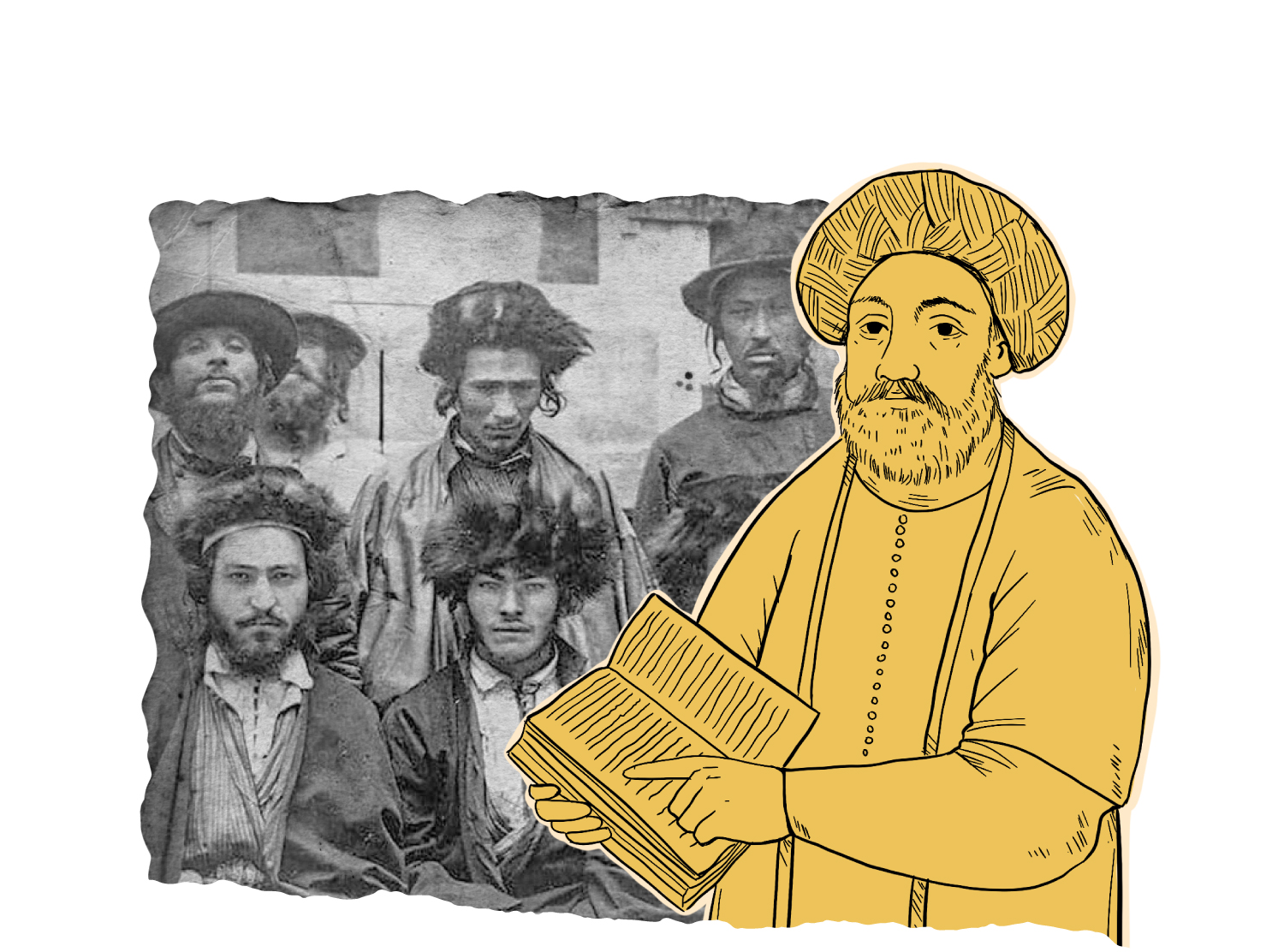
"They took over the minds of the sultans and took control of the most dangerous positions"
Dönmeh Jews
Zionists Inside the Palaces of the Ottoman Empire
Studying the history of the relationship between the Jews and the Ottoman Empire is the historical key to understanding the cooperative interactions and settlements between the Turks and the Zionists. The Jews were aiming towards preserving their race, and for a nurturing environment for them and their money, while the Ottomans needed the Jews’ money and experience to contribute to the colonial and expansionist project of the state.
Despite the freedom that the Jews enjoyed under the protection of the Ottoman Empire, the reality of the diaspora and the dream of building a state with a religious identity continued to stir the collective yearning of the Jewish Zionists. In the face of this institutional and identity coercion, the “Dönmeh Jews” movement surfaced in the 17th century at the hands of Sabbatai Zevi (1626-1675), and claimed to be the Savior Messiah who came to save the Children of Israel, put an end to the diaspora that the followers of Judaism were in, and establish the Kingdom of Israel in the Promised Land.
The emergence of the Dönmeh movement constitutes the first foreshadowing for the establishment of the concepts of Zionism in its ideological and political aspects, given that Sabbatai Zevi’s call was an unusual one that was not accepted even by some Jews of the Ottoman Empire, which prompted some of them to denounce the self-proclaimed “Savior” to the Ottoman court, which forced him to publicize his conversion to Islam, even if it was a “taqiyya”; as he was afraid of being accused of breaking out against the Ottoman Empire and establishing an organization that seeks to separate from the Sultanate, he chose Islam and changed his name to “Muhammad Aziz Effendi”.
The emergence of the Dönmeh Jews was the first foreshadowing of the Zionist movement that sought settlements with the Ottoman Empire to occupy Palestine eventually.

Even though some people assert that the Dönmeh Jews had enabling political goals aspiring to control the Ottoman Sultanate from within by achieving an integrated political project aimed at disengaging the Ottoman Empire from the Arab states on the one hand, and increasing the discontent of the Islamic peoples with the Turkification policy on the other hand, we believe that they wanted to achieve their dream of establishing a state outside the borders of the Ottoman Empire, which was never intended to be their promised land, unlike the rest of the countries that were promoted (Palestine, Yemen, Abyssinia…). This fact is confirmed by the call of Sabbatai himself, who called for the establishment of a national home for the Jews in Palestine in particular.
Perhaps what confirms this proposition is the absence of a harsh counter opposition on the part of the Ottoman Empire against Sabbatai Zevi followers, whether those who had outwardly converted to Islam, or those who insisted on preserving their Judaism, which confirms that the Ottomans were aware that the political project of the Jews was not directed to overthrowing their state, rather it was directed to the establishment of a political entity on the land of Palestine, which the Sultanate did not harshly oppose against, even if its followers claimed the opposite.
The movement founder’s cunning tactic allowed him to ease his way to the institutions of the Ottoman Empire, which appointed him as “head of the doorkeepers”, which displeased his followers at first, before he convinced them that this tactic was their way to spread their new call. He addressed his followers by saying: “I am your brother, Muhammad Al-Bawab. God has commanded, and I have obeyed. The Jewish scriptures mentioned that the Messiah would be followed by Muslims.”
The Ottomans learned that the political project of Zionism was not directed at overthrowing their state, but rather aimed at establishing a political entity in Palestine.

The vigor of this movement enabled its followers to reach leadership positions in the state, and some of them assumed the position of Grand Vizier, as is the case for Midhat Pasha, who was known to be a Jew who concealed the truth of his religion in order to succeed in assuming important Ottoman states such as the State of Syria. He is also known for deposing Sultan Abdul Hamid and plotting his assassination six days after his deposition.
The influence of the Dönmeh Jews in the Ottoman political decision is due to their awareness of the power of the media and its ability to direct public opinion according to the agendas of their organization, with the evidence being that no one at that time dared to expose them in any newspaper or magazine; because most newspapers and magazines were owned by the Dönmeh Jews.
It can be said that the Dönmeh Jews were able to scheme their way into the Ottoman political decision, and they were helped by the corruption of the system and the ease of exploiting its circumstances, in addition to the support of those holding the political decision in the state. Even the people who were trying to warn against them or confront them were “submitting complaints to the leaders of the state to cancel and harass anyone who criticizes against them”, especially those who were publishers.


- Sinan Sadiq Jawad, “The Dönmeh Jews: Their Origin and Impact in the Ottoman Empire until 1909”, Diyala Magazine, p. 55 (2012).
- Ahmed Nouri Al-Nuaimi, “The Ottoman Empire and the Jews” (Beirut: Dar Al-Bashir, 1997).
- Irma Lvovna Fadeeva, “The Jews in the Ottoman Empire, Pages in History”, translated by: Anwar Muhammad Ibrahim (Cairo: The National Center for Translation, 2020).
- Stanford J. Shaw, The Jews of the Ottoman Empire and the Turkish Republic (Cairo: Dar Al-Bashir, 2015).


